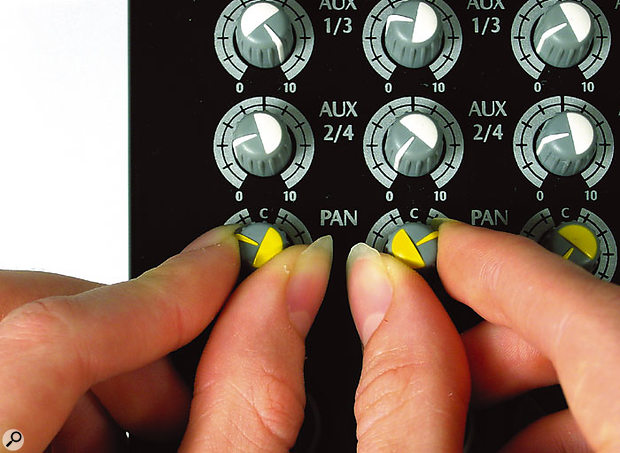 Different mixers employ different panning laws.
Different mixers employ different panning laws.
When I plug my guitar into my 16-track and send the same signal to two channels, if I pan both channels to the middle it sounds louder than if I pan one all the way left and one all the way right. Surely it should sound the same — if they are both in the middle, the signal is coming through both speakers, and if one is panned left and one right, it's still coming through both speakers. Can you explain what's going on?
SOS Forum Post
Technical Editor Hugh Robjohns replies: Panning laws vary between products, depending on whether they are designed to maintain constant voltage, constant power, or a compromise between the two. The compromise version is probably the most common these days, with pan pots designed to provide something like a 4.5dB attenuation when at the centre. Constant power gives 3dB of centre attenuation, while constant voltage gives 6dB.
If you pan identical signals fully left and right, you have full-level signals in each output channel. However, if you pan the signal to the centre, the left and right outputs will be attenuated by (in the case of the common 'compromise' panning law) 4.5dB. But because you have panned both input channels to the centre, each output channel is receiving two lots of signal, each 4.5dB lower than the level of a single channel panned fully left or right. Since your two signals are identical, they will sum together and the level will rise by 6dB. So we go up 6dB from -4.5dB and find that each output channel is now carrying a summed mix of +1.5dB. Hence, each output channel is now carrying a signal that is 1.5dB higher than it was when you panned the channels individually left and right, so it will sound slightly louder.
For the record, if the mixing desk employed the constant power law, with 3dB central attenuation, the two channels panned centrally would produce an output of +3dB in each channel, while a desk with the constant voltage law would produce an output that was exactly the same level as the fully panned channels (in terms of signal voltage, at least).
The constant power panning law is used where you want a panned signal to remain at more or less the same perceived volume regardless of where you pan it. However, this panning law looks wrong on the desk meters, which only show a constant level if you use the constant voltage law! Hence the halfway-house compromise law, which tries to satisfy the demands of both situations reasonably well.
